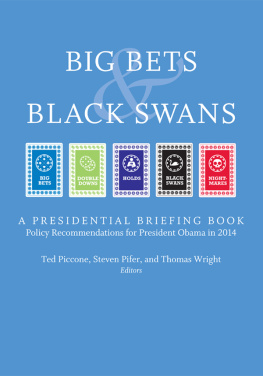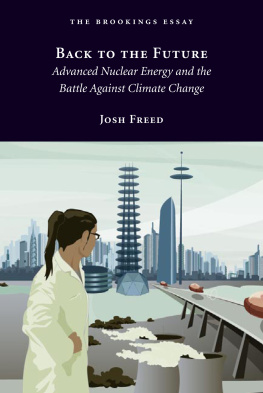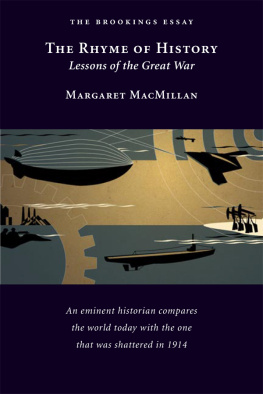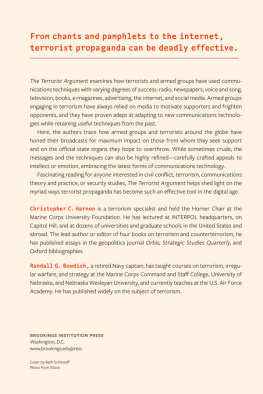THE BROOKINGS ESSAY
In the spirit of its commitment to high-quality, independent research, the Brookings Institution has commissioned works on major topics of public policy by distinguished authors, including Brookings scholars. The Brookings Essay is a multi-platform product aimed to engage readers in open dialogue and debate. The views expressed, however, are solely those of the author.
You can access the entire Brookings Essay series online at
www.brookings.edu/essay
Copyright 2013
THE BROOKINGS INSTITUTION
1775 Massachusetts Avenue, N.W., Washington, DC 20036.
www.brookings.edu
All rights reserved. No part of this publication may be reproduced or transmitted in any form or by any means without permission in writing from the Brookings Institution Press.
ISBN 978-0-8157-2586-2 (ebook)
Cover illustration by Marcia Underwood
THE SYCAMORE TREES that line the northern stretches of Vali Asr Avenue in Tehran arch overhead like a canopy. In the winter, their snowy branches frame a view of the Alborz Mountains where Tehranis escape to hike or ski. On a summer day, the leaves filter the sun and smog in the affluent northern neighborhoods, and you can watch the temperature rise by ten degrees as you inch your way southward in the city's infamous traffic toward the heart of old Tehran.
Vali Asr is said to be the longest street in the Middle East; and sometimes it feels like the only straight path in a nation whose course has been highly unpredictable and intensely complicated ever since the 1979 revolution which ousted the secular, pro-American shah and installed a theocracy led by Ayatollah Ruhollah Khomeini. It was on Vali Asr, 18 years later, that young Iranians erupted in joy in the largest spontaneous public demonstrations the capital had seen since the revolution. The immediate cause for celebration in 1997 was the national team's World Cup qualification, but for many it was a belated response to the recent election of a president who promised reform. Mohammad Khatami's victory represented a moment when the country appeared on the cusp of change again. His promises went largely unfulfilled, however, doomed by the intractability of the defenders of Iran's religious orthodoxyamong them the supreme leader, Ayatollah Ali Khamenei.
For Shi'a Muslims, the phrase 'Vali Asr' symbolizes hope in a just future; for Iranians, the revolution has brought anything but.
Yet, on the eve of another election in 2009, Iranians returned to Vali Asr in another powerful display of the will of the people. Thousands of Iranians linked arms in a human chain that stretched the full 12 miles of Vali Asr to express their support of reformist candidate Mir-Hossein Mousavi. Less than a week later, however, huge crowds gathered there again, this time to denounce the apparently rigged victory of the incumbent, Mahmoud Ahmadinejad, a man infamous for his bigotry and provocative policies. The protestors initial chants of where is my vote? met with police batons and bullets. The violence that ended the demonstrations, and the show trials and other Stalinist tactics that followed, suggested that the theocracy no longer saw the need for even the fig leaf of semi-orchestrated elections, and instead had devolved to a more naked authoritarianism. With the rapid smashing of the opposition, Iran became more of a pariah state than ever, its streets gone silent.
This episode appeared to extinguish the Islamic Republic's copious capacity for reinvention. But something happened along the way to the latest election, in June 2013: Iran's political narrative once again defied expectations. A brief and unprecedentedly outspoken campaign gave voice to criticisms of the regime that might once have landed some of the candidates in jail. In the end, it was the candidate who appealed most forcefully for a new path who won the presidency, with a resounding majority.
Like his mentor Rafsanjani a quarter-century ago, Rouhani appears to have been tapped to effect a turnaroundto staunch a crisis and salvage the revolution from its own failings.
In the aftermath of the vote, throngs of Iranians once again poured onto Vali Asr for spur-of-the-moment street parties. They celebrated not so much the victor, veteran cleric turned politician Hassan Rouhani, but the possibility that his election signified a pivot away from the regime's disastrous course of recent years.
Even if this proves trueeven if Tehran is stepping back from the brink of its ruinous battle with much of the rest of the worldthere is no guarantee that Rouhani's election will put an end to the uncertainty that has enveloped Iranian politics for more than three decades, or lessen the antagonism between the Iranian leadership and the West. Rouhani campaigned on a slogan of hope and prudence, two commodities that have been in short supply since the 1979 revolution. Delivering on that promise may prove the toughest course the Islamic Republic has yet had to navigate.
From the Reign of the Shahs to an Enduring Revolution
Vali Asr was constructed after Persia's crumbling Qajar dynasty gave way in 1925 to an army-installed monarchy. Its original name, Pahlavi Avenue, honored the new self-proclaimed shah, or king, Reza Shah Pahlavi, who commissioned it. The broad boulevard became the central thoroughfare in Iran's capital, linking the royal palaces and state institutions with the train station that was the anchor of the shah's industrialization effort. Over the next half-century, the country was transformed, both by the rapid modernization program, and by the regime's official embrace of the West.
Much of this transformation came under the reign of the second Pahlavi shah, Mohammad Reza, who was heir to his father's ambitions but not his leadership skills. His initial years at the helm of the state proved rocky. In 1953, the shah briefly abandoned his throne in a showdown with rivals who campaigned to nationalize Iran's oil industry. The leader of this movement, Prime Minister Mohammad Mossadegh, was ousted in a coup orchestrated by Washington and London, after which the monarchy was reinstated and reinforced. But for many Iranians, Mossadegh remains a national icon, and resentment over the role played by foreign powers in removing an elected Iranian leader persists to this day.
Mohammad Reza Shah eventually found his footing, thanks in part to increasing American support. Washington appreciated the value of a reliable, energy-rich ally as a bulwark against Soviet expansion into the Middle East, and the shah hungered for validation and influence. But American-Iranian relations were tempestuous from the starta peculiar stew of admiration and resentment on both sides. Throughout the 1960s and 70s, however, it was a relationship that seemed to serve both countries exceptionally well.
Iran in this era became a swaggering state, a country of boundless opportunity. While courting superpowers both east and west, Tehran helped to orchestrate the historic transformation of the global oil industry, which transferred controland profitsof the world's energy resources to the states that owned them. Fuelled by grandiose ambitions and revulsion toward traditionalism, the shah channeled his vast oil profits into a mad dash for modernity.
Along the way, Iran made much progress. Most importantand often overlooked in the post-revolutionary demonization of the monarchymillions of Iranians achieved a middle-class existence. The country became an international hotspot: Western bankers jostled for Iranian petrodollars; Harvard Business School opened a campus; tourists from around the world flocked to see the ruins of ancient Persia; diplomats clamored for a Tehran posting.
But amid this rapid development, something was lost. Iranian society was in flux: its economy was simultaneously expanding and imploding, its religion and customs were under siege, its traditional channels of influence eroding under the pressure of a state determined to assert its dominance. Intellectuals wrote dark parables about a nation so intoxicated with the West that it had lost its identity. Even as the shah was pouring money into his notion of an ideal society, pockets of opposition were developing.










